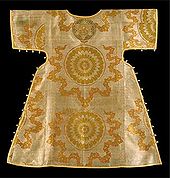Jackets
The jacket ( Greek σάκκος) is a liturgical garment of the bishops and patriarchs of Orthodox and Uniate Eastern Churches and is worn instead of the priestly Phelonion .
Appearance
The jacket is a tunic with wide sleeves and a distinctive decorative pattern. It reaches below the knees and is closed at the side with buttons or ribbons. In shape and appearance it is similar to the western dalmatic , which, like the jackets, is based on Byzantine garments.
The jacket is usually made of fine brocade fabric and can be decorated with elaborate embroidery. A special cross is usually embroidered on the back, which plays a role in the dressing ceremony. In addition, loops or buttons are usually sewn on the top of the back, to which the episcopal omophorion is attached. Often a total of 33 buttons are attached to a jacket, which is the traditional number of years of Jesus' life . In addition, bells are attached to the hem, which go back to the biblical instructions for the clothing of the Jewish high priests ( Ex 28.33–34 EU ; 39.25–26 EU ).
history
The jacket was originally worn by the Byzantine emperor as an imperial item of clothing. During this time, the bishops did not wear jackets, but a Phelonion , similar to that worn by today's Eastern Church priests, but with an elaborately embroidered, multi-layered cross, called Polystavrion ("many crosses"). The first clergy to adopt the jackets as liturgical clothing in the 16th century were the patriarchs and some high-ranking archbishops , and these too only used jackets at high feasts . The other bishops continued to wear a Phelonion or Polystavrion. After the fall of Constantinople (1453) , they too were given the right to wear jackets. Unlike the pontificals of Western rites, which prelates below the rank of bishop may also wear, the jackets are reserved exclusively for bishops.
Use and special features
The bishop wears the jackets as part of the sacred robe at the celebration of the Divine Liturgy , at the high doxology in the course of Mette or a vigil, as well as on special occasions such. B. at Easter , when taking out the epitaph on Good Friday or the cross during the exaltation of the cross . At other, non-liturgical celebrations, the bishops of the Eastern Church wear the "mantiya", the episcopal cloak.
When the bishop is dressed, two sub-deacons present him the jackets on a plate, the bishop blesses him with both hands and the sub-deacons lift the robe from the plate so that the bishop can kiss the cross on the back. The jacket is then put on and the sub-deacons fasten the buttons on both sides. The bishop usually wears a sticharion under his jacket .
Some rites a bishop on request can celebrate "as priests", where he does not bear the Episcopal (Episcopal) Clothing and also to the Episcopal candlesticks, dikirion and trikirion waived. The bishop then only wears a simple phelonion with the small omophorion over the shoulders and the epigonation on the side. In addition, as on all occasions, he wears his Panagia .
Web links
Individual evidence
- ↑ Dressing a bishop in a jacket ( memento of the original from November 5, 2004 in the Internet Archive ) Info: The archive link has been inserted automatically and has not yet been checked. Please check the original and archive link according to the instructions and then remove this notice.

